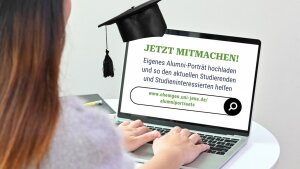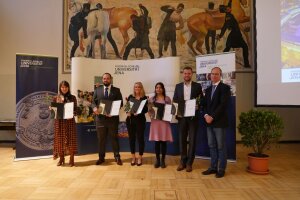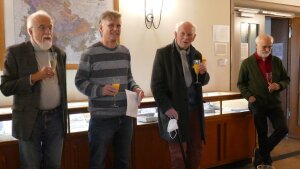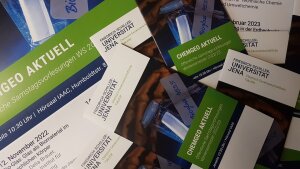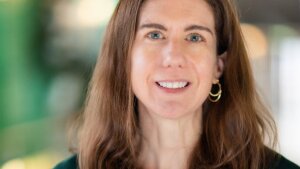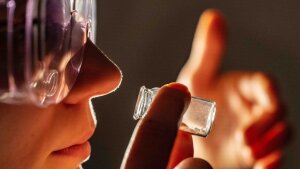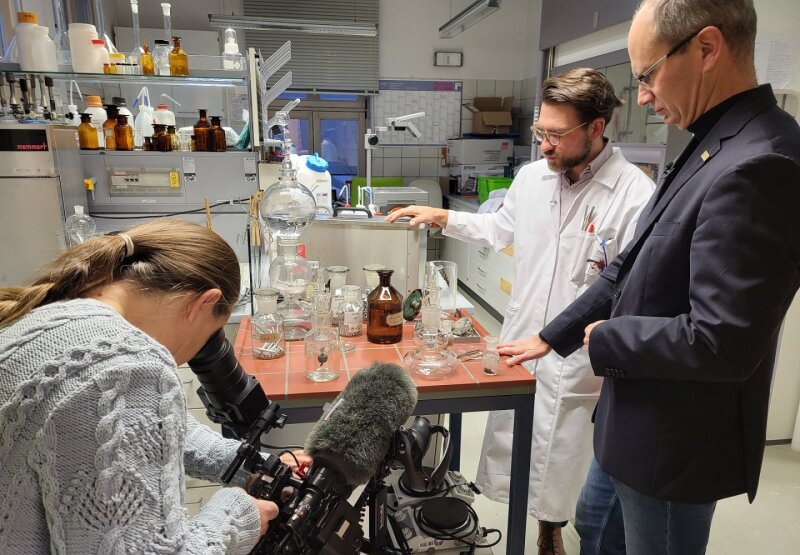ChemGeo Alumni-Newsletter WiSe 2022/23
Dear Alumni and Friends of the Faculty of Chemistry and Earth Sciences,
How did you fare after graduation and how do you look back on your time studying in Jena? On our website, some alumni already report on their experiences. With these alumni portraits, we would like to show students and prospective students the diverse possibilities after graduation - and thus help them with their career orientation.
We are therefore always happy to receive new testimonials!
Find out how you can easily create your own portrait online in this newsletter - and there are, of course, much more news in this issue.
Yours
Claudia Hilbert
(Deans Office Faculty of Chemistry and Earth Sciences)
Content
News from the faculty (and university)
- Alumni portraits wanted: Take part now and upload your own portrait
- Review Graduation Ceremony 2022
- Institute for Geosciences celebrated 30th birthday
- Watch Saturday Lectures online
- Podcast tip: SpacEconomics - The podcast about (economic) geography
News around research and teaching
- Leibniz Prize for chemist Sarah O'Connor
- Novel polymers encapsulate fragrances
- Asteroid impact in slow motion
Impressions from Jena: Film shoot for the Döbereiner lighter
Graduation ceremony 2022: Presentation of certificates to doctoral graduates
Image: Claudia Hilbert/ Universität JenaReview Graduation Ceremony 2022
The graduation ceremony is a special highlight every year - and on 4 November 2022 it was finally able to take place regularly in the auditorium again after the Corona restrictions in previous years!
All Bachelor's, Master's and doctoral graduates received their certificates. In addition, the faculty's doctoral and examination prizes were awarded. The solo ensemble of the Brass Band Blechklang provided the musical accompaniment.
On the website you will find an overview of all graduates and prize winners. You can also view the video and a photo gallery of the ceremony in the auditorium:
Graduates 2022: All names as well as photos and video of the graduation ceremony
Aufzeichnung der Absolventenfeier am 4. November 2022
Celebrating the 30th anniversary of the IGW: Prof. em. Peter Malischewsky, Prof. Ulrich Wegler (member of the current Institute Directorate), Prof. em. Klaus Heide (since the founding of the Institute), Dr Thomas Jahr (from left to right)
Image: Kamil Ustaszewski/ Universität JenaInstitute for Geosciences celebrated 30th birthday
In October 2022, the Institute of Geosciences celebrated its 30th anniversary. Former professors Prof. Dr Reinhard Gaupp, Prof. Dr Klaus Heide and Prof. Dr Peter Malischewsky were among those present at the anniversary drink in the institute building on Burgweg.
Short review: On Friday, 23 October 1992, the Institute of the Institute of Geosciences was re-established with a ceremonial act in the assembly hall in the main university building. On Monday, 26 October 1992, teaching began in the lecture hall of the new Institute at Burgweg 11.
And the Faculty of Chemistry and Earth Sciences also had a round birthday: On 20 November 1992, also 30 years ago, the Senate of the university decided to incorporate Geosciences and Geography into the then Faculty of Chemistry. This was accompanied by a change of name - the birth of today's name of the Faculty of Chemistry Sciences and Earth Sciences.
Book "25 Years of the Institute of Geosciences"
By the way: On the occasion of the 25th anniversary of the Institute of Geosciences, a book was published with many interesting insights into the history of the Institute and the architecture of the Institute building. The book is written in German. It is available in the university shop:
Book "25 Years of the Institute of Geosciences" in the university shopExternal link
The public Saturday lectures in the winter semester 2022/23 are also available as videos for the first time.
Image: Claudia Hilbert/ Universität JenaWatch Saturday Lectures online
You missed the Public Saturday Lectures in the winter semester 2022/23? No problem! For the first time, all four lectures were recorded and are now also available as a video. So you can watch the lectures again at any time from your sofa at home.
Here is the overview of the topics:
- Bio-glass: Glass as a biomaterial in the human body
Prof. Dr Delia Brauer - Castles and monasteries: Where did the building blocks come from?
PD Dr Thomas Voigt - Really Green: How to Quantify Environmental Impacts?
Prof. em. Dr Günter Kreisel - E-Learning in Earth Observation: Basics, Challenges and Modern Solutions
Robert Eckardt
Please note: Alle lectures are in German.
Cover of the "SpacEconomics" podcast
Image: Lehrstuhl WirtschaftsgeographiePodcast tip: SpacEconomics - The podcast about (economic) geography
Are culturally diverse regions more innovative? Are new ways of working changing the economy? And are the 17 Sustainable Development Goals (SDGs) of the United Nations realistic guidelines or mere utopia?
These and similar questions from (economic) geographic research are the subject of the podcast "SpacEconomics" by the Economic Geography Working Group. The podcast provides insights into the everyday scientific life of geographers, provides debates on unusual publications, explains economic geographic theories and discusses current topics from studies and teaching.
Björn Braunschweig, member of staff at the Chair of Economic Geography and editor-in-chief of the podcast, regularly invites guests such as students or researchers from other universities.
It's worth listening in!
Podcast SpacEconomics: Website with all episodesExternal link
PhD student Frieda Nagler smells a fragrance encapsulation whose odor can be detected through the nose.
Image: Jens Meyer (University of Jena)Novel polymers encapsulate fragrances
Fragrances from cosmetics or cleaning products are pleasant. But they can also end up in wastewater and thus pollute the environment.
A team led by Prof. Dr. Felix H Schacher from the Institute of Organic Chemistry and Macromolecular Chemistry has developed novel polymers with which fragrances can be encapsulated and thus released in doses over a longer period of time. This could significantly reduce the environmental pollution caused by fragrances.
The scientists have published their results in the journal ACS Applied Materials & Interfaces.
Learn more about the study on fragrance encapsulation de
Asteroid impact in slow motion
For the first time, scientists have followed live exactly what happens in the material hit by an asteroid impact. The team led by mineralogist Prof. Dr Falko Langenhorst from the Institute of Geosciences of the University of Jena and Hanns-Peter Liermann from the German Electron Synchrotron DESY recreated an asteroid impact with quartz in the laboratory and let it happen in slow motion in a high-pressure cell.
The observation reveals an intermediate state in the quartz under investigation and thus solves a decades-old mystery about the formation of characteristic structures in the mineral, which is ubiquitous on the Earth's surface. The team presents their results in the scientific journal "Nature Communications".
Learn more about the live recording of an asteroid impact
